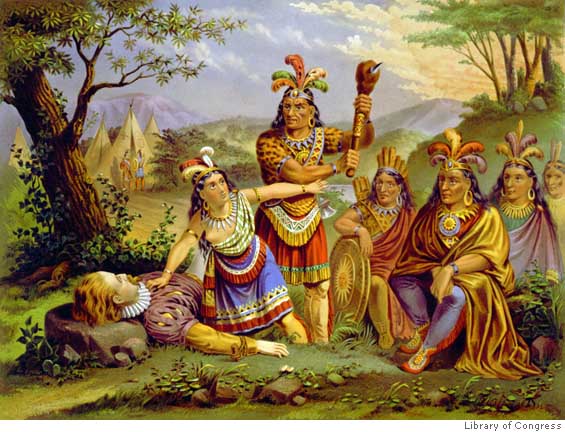Pocahontas Revealed is an excellent
Nova documentary on America's "Indian princess." Even though I've read a lot about
Pocahontas, I learned things. Telling you things you didn't know, filling the gaps in your knowledge, is a mark of good filmmaking.
Pocahontas Revealed focuses on the
discovery of Werewocomoco, the home of Powhatan and Pocahontas. It explores several mysteries about the site. What was the purpose of two 700-foot-long ditches? Do a few post holes show the location of Powhatan's longhouse? Do the bits of copper found come from Native sources in the Great Lakes or from Great Britain? Can tree rings tell us why the Indians stopped helping Jamestown after seven months of cooperation?
So the documentary isn't just a laundry list of "this happened, this happened, and this happened," which inevitably gets boring. Rather it presents a series of revelations as the information is uncovered. Moreover, it uses computer graphics and staged recreations to enhance the narrative, making the story fun.
What I learnedHere are some of the things I gleaned from
Pocahontas Revealed.
When Smith and company arrived in Virginia, the Indians attacked them with bows and arrows. They knew about the white man from Roanoke and prior Spanish explorations. Their arrows seemed to be an explicit message: Go home...you're not wanted here...no trespassers allowed.The Englishman set up camp at Jamestown anyway. They ignored the warning and settle in Indian territory without permission. Here's a clear indication of their immoral intent. Regardless of how the Indians felt about it, the Englishmen were going to take what they wanted from them.The Englishmen were all tradesmen and craftsmen. They were there to take resources, shape them into useful products, and ship them home. The only freedom they cared about was the freedom to profit from Indian land.There were no farmers among the English. Their plan was to buy food from the Indians, not grow it themselves. When the Indians refuse to trade, this turned out to be a tragic mistake.Pocahontas's roleWhen Smith first recounted his capture by the Powhatan Indians, he wrote that they feasted him, interviewed him, and sent him to bed. He didn't say anything about Pocahontas rescuing him until 17 years later. As the narrator notes, accounts written closer to the time of an incident are almost always more accurate.In the documentary, Pocahontas is played by 13-year-old granddaughter of the Rappahannock chief. She's cute but not Hollywood beautiful; she looks her age. This makes it harder to imagine a romance between her and Smith.The copper bits found at Werewocomoco are industrial waste from the mills in England. The Englishmen traded this scrap metal with the Indians for food. To the Indians, the gleaming copper probably seemed like gold to us.Left unsaid is the exact nature of the trade. The Englishmen were trading what they considered worthless refuse for valuable foodstuffs. But the Indians may have thought, "Look at this highly processed metal ore. Think how much effort it took to mine it, smelt it, pound it into sheets, and ship it overseas. For this they want a few baskets of food they could easily grow themselves? Suckers!"
Horn dogs and EnglishmenArtifacts showed that Indian women stayed at Jamestown with the settlers. The English said nothing about these women, but they probably had sexual relations with them. In fact, Spanish records suggest that there were some 50 marriages between English men and Indian women at Jamestown.Tree rings indicate there was a drought from 1606 to 1612. Apparently it was drier than any other seven-year stretch in the Chesapeake area in the last 800 years. This may explain why the Indians stopped trading with the Englishmen: They didn't have any surplus food. It may also explain why the Englishman failed so miserably at growing their own crops.Faced with hunger, Smith and the others began burning down villages and killing Indians to get what they wanted. Forget all the talk about disease. The English not only had a genocidal intent, they acted upon it. From the very beginning, their plan was to kill or conquer anyone who got in their way.In short,
Pocahontas Revealed is about as good as historical documentaries get. If you have a chance, see it. Rob's rating: 8.5 of 10.
For more on the subject, see
Native Documentaries and News.



4 comments:
"When Smith and company arrived in Virginia, the Indians attacked them with bows and arrows. They knew about the white man from Roanoke and prior Spanish explorations. Their arrows seemed to be an explicit message: Go home...you're not wanted here...no trespassers allowed."
Sounds like a perfect example of the 'shoot first ask questions later' mentality you're always ranting about.
I'm not grokking your review system, Rob. "Lonesome Dove" is rather problematic, and gets 7.5 out of 10 from you. This documentary gets all-around glowing praise, and is only ranked one point higher, at 8.5 out of 10.
For my response to your comment, Anonymous, see Shoot First, Ask Questions Later?
For an answer to your question, DMarks, see My Rating System Explained.
Post a Comment